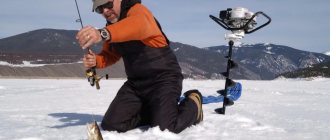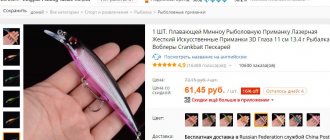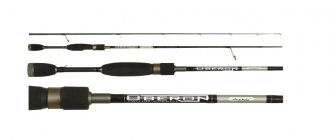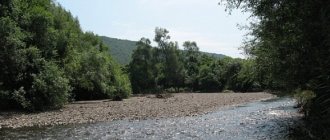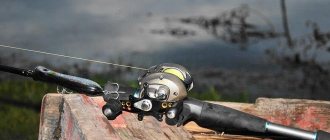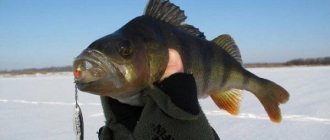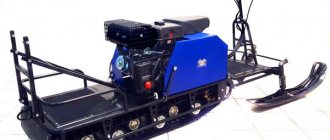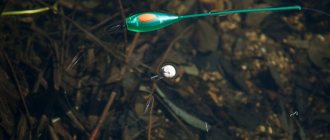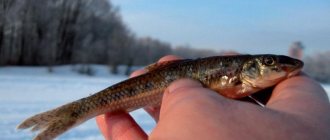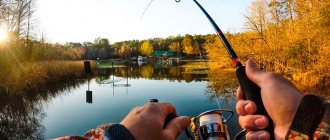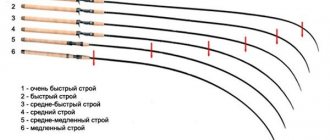The small klepsin leech is a reliable bait for catching fish of many species that live in the rivers of central Russia. Anyone who has learned to fish with a leech always has a good catch. But fishing with this bait has its own secrets.
Once I spent half a day with a float rod on Pakhra, content with only occasional bites of small roach. No matter how sophisticated I fed, no matter what attachments I used, nothing worked.
And the day was good, and I didn’t want to go home. But the fish didn’t take it... And then a friend called me on my mobile phone and boasted about his excellent catch. It turns out that he was fishing on the same river, not far from me - on a shallow riffle near the Solnechnaya Polyana dacha, and used a small leech as a bait. You can also use black leech as bait
Without hesitation, I went to this riffle, and by the evening, thanks to my friend, who shared the bait with me and discovered the secret of fishing with a leech, I became the owner of a solid catch.
Clepsina is a small, harmless leech of light brown color, usually 2-4 cm in size. It lives under stones, on the back of water lilies and some other aquatic plants, sometimes on their stems and roots. Prefers water areas adjacent to fast currents, where the water is rich in oxygen.
In summer, the easiest way to collect leeches is from a boat. To do this, you need to move through the thickets of water lilies and, lifting the glossy leaves, inspect their underside. In spring and autumn, klepsin are collected under stones. This is done like this: in the area of rifts and near dams, boulders are turned over and leeches are found attached to their lower side. Place the klepsin in a glass jar with a lid, in which you need to make small holes.
A variety of fish love leeches, probably because they are very nutritious as food, and in addition, these leeches are familiar to fish, which prefer to stay in areas where the water is well enriched with oxygen.
A strong stream washing the stones will, no, no, even tear off the leech from them and carry it downstream. The fish is accustomed to such gifts and guards its prey. Leeches are washed away especially well where rivers are regulated and the flow in them accelerates on some days and decreases on others.
Read: What to do if you run out of bait?
Fish activity is higher when the current speed increases. The success of fishing greatly depends on the correct choice of jet. If the fish does not bite on the leech, you need to cast closer or further to find the stream that the fish chose, then success is guaranteed.
You can fish with klepsin throughout the open water season. It is especially attractive for fish in spring and autumn, and in summer, when due to the strong heating of the water most fish move closer to the fast stream, this nozzle is effective even in the heat.
They bait a leech by piercing it with a hook through the middle of the body. This bait is most effective near dams, at spillways, on rifts, near rocky islands, in a word, where clepsin is found on the bottom or in algae.
You can fish from a boat or wade. For the first time, I caught a leech while standing on a riffle in waders, and my friend did it from a boat. Moreover, the fish were not afraid of it, although the depth at the riffle was no more than 1.5 m.
Of course, when fishing in shallow waters, it is difficult to count on large fish, since they are very shy. However, a stable catch of individuals weighing 200-300 g on Pakhra is, you see, not so bad! Moreover, they mixed in roach, white bream, silver bream, chub, perch and even a small asp.
Leech Power
Summer is the golden time for the great seasonal bait, the black leech. It is seasonal, when it works much better compared to other periods of open water. Only in June-July are 300-600 g of roach caught on a leech, and already with the arrival of August, it’s as if there are no such fish in the river. After spawning, it eats up to a kilogram of leeches and silver bream. Often ides are caught with 1-1.5 kg, or even three rubles will fly in. And, of course, perch. The size of the humpback whale has decreased somewhat over the past five years, however, a striped predator of 300-500 g is common, and large perch of 600-800 g also jumps on a leech.
Baiting leeches on a hook
Leech on a hook
There are two ways to bait a leech on a hook:
- Nozzle via suction cup.
Pierce the body of the leech so that the hook passes through the front part and comes out in the middle of the suction cup, then we pierce the body of the leech so that the hook comes out. The hook sting is not masked. - Nozzle through the middle of the body.
This method of baiting allows the leech to wriggle in the water, which will certainly tempt the fish to treat itself. This method is applicable in cases where small perches do not try to “pluck” the leech. A leech suspended in the depths of the water wriggles, attracting fish to a much greater extent than when it is attached to one end of the body. For bottom fishing, it is recommended to attach several leeches at once; sometimes, to improve the bite, you can add a crawler to them in company.
Where to catch a leech
This is the main question of leech fishing. Bites are possible everywhere. But the most promising places are located along the coastal thickets of water lilies, where the main “stock” of leeches is located, and this is where the fish find them. By the way, if there is a low-water year, then, as a rule, there are always few leeches, and you have to stock up on them in ditches and swamps. But this moment is connected only with the problems of obtaining bait, and not with the craving of the fish to feed on the “little little one.”
The most promising places are where young grass and young water lilies grow in the area of the surface water lily, at its roots - the fish love to stay here, perhaps there is more food, and the current is weaker. It is only important that the depth of the burdock wall is at least 1.5 m. If it is shallower, then there are usually a lot of small fish there.
The structure of the bottom of water lilies is not important - a good bite can be found both on a muddy bottom and on a shell bottom - so hard that when you step on it, you might think that it is some kind of concrete.
Catching leeches
Unlike maggots, there are no leeches for fishing in fishing stores. And why buy them if they live in almost all rivers and large lakes? The bait is collected in a shallow coastal zone with a heavily silted bottom covered with algae.
In their native element, leeches are too nimble and slippery; in the water, catching them with your hands is quite problematic. Therefore, fishermen came up with a simple but effective way to catch leeches. You just need to drag more mud ashore and carefully sort through it. This process requires maximum care, since the leeches literally merge with the dirt.
On multi-day fishing trips, leeches can be lured with meat scraps or pieces of caught fish. They sense such a delicacy from a great distance; with its help, they can be lured out of the thickets to a clean area. If there is no excess meat, but you feel sorry for the fish, then a killed frog will help out.
Efficiency of half-bottom
How to serve a leech to fish is the second most important question. Ideally, this bait should be fixed motionless on the bottom, wriggling in place; accordingly, wire fishing for beer is swept away. In addition, fishing close to a jug plant constantly threatens with hooks - you need to fish clearly, as accurately as possible, casting it in the same place, so the donk and reel are also swept aside. It is not surprising that the good old half-bottom asks for the main role here, which, with a regular swing cast, places the equipment 2-4 m from the boat at the same point. And the fish is not at all afraid of me or the boat, if there is no noise in it. By the way, attempts to fish like this with a “ringing” duralumin boat showed poor results.
Usually I place the boat along the water lilies, tying it to the grass, a suitable bush, or lowering the anchor, and cast it along the water lilies - closer to them. You can drive the boat into the water lily itself, thereby being well camouflaged, and cast across the stream, moving the tip of the fishing rod slightly beyond the wall of water lilies. But in fact, strict camouflage is practically of no use, and catching large specimens is much more difficult. This is still a large silver bream or ide, usually after hooking they tear to the middle of the river, where they came for the leech, and the humpback whale for the most part tends to go to its den - the water lily thickets, and big problems arise.
I fish with two half-bottoms - this is a reasonable maximum, even with a certain skill. Three rigs are guaranteed to lead to overlapping rigs when fishing, especially for humpback salmon.
The tackle was assembled on the basis of a strong carbon fiber fly fishing rod 5 m long. A small wire reel with a supply of fishing line of 0.2-0.22 mm is attached to the butt. I insert a sliding weight of 7-10 g into the rig, resting against a stopper 50-60 cm from a hook the size of a leech. There are no guide rings on the fishing rod - they help the fishing line catch on the grass and reduce the sensitivity of the gear in the wind - it blows out arcs between the rings. The line from the reel goes directly to the tip, where it is tightly fixed with a cambric. When fishing, I can lose a little line by loosening the reel brake. But usually this is not necessary. The reel here is simply a storage area for a supply of fishing line, because I fish without a leash, and after breaks I can quickly restore the working length of the fishing line equal to the length of the rod.
There are no alarms - the bite is clearly visible at the tip of the fishing rod or in your hand. Often a bite is brought about by playing along - a smooth pull of the rig towards you.
I usually do half-bottom fishing on a stationary basis, as I know the places well. If you don’t have such knowledge, then it’s advantageous to look for fish without lingering for a long time at points where they don’t bite. But this usual fishing is limited only in the morning or late evening.
Without float
Some fishermen get by without a float when fishing in the riffles. In this case, on a fishing line with a diameter of 0.14-0.16 mm, only a lead pellet weighing 3-7 g remains, immediately after which a leash 0.12-0.14 mm thick and 10-20 cm long, depending on the strength, is attached through a micro-swivel currents.
The leash ends with a reliable hook that can withstand the jerks of a strong fish. The moment a fish bites is determined by the vibrations of the flexible tip of the rod tip, but experienced fishermen have learned to determine the moment of a bite by the movement of the fishing line.
Read: How to preserve bloodworms in winter at home
To do this, it is better to take a high-quality monofilament of alternating colors in different colors - this way the bites will become more noticeable. The fisherman needs to carefully monitor the fishing line, which marks the movement of the bait along the uneven bottom. With such equipment it is good to fish local places in the zone of bottom depressions, near large stones and where there is a drop to depth below the riffle.
How to catch a leech for fishing?
You can get leeches directly from a pond with a silted bottom. If there are a lot of stones along the shore and a little further in the water, then it makes sense to look for leeches under them. A large number of leeches are found in watering areas for cows and other livestock. Before the rain, black leeches can be collected near the shore.
There are many leeches in the reservoirs in which snails live - their natural food. To attract a sufficient number of leeches to one place, you can take chicken giblets or meat scraps from other poultry, wrap them in gauze or, better yet, in a mesh bag, and place it all near the shore. After several hours of being in the water, a lot of leeches will collect on the meat waste, which will be suitable as bait for fishing for catfish and other large fish.
You can simply use a shovel or rake to take the silt to the shore and level it. You won't have to wait long. When the water flows out, the leeches themselves will begin to crawl out of the silt towards the water. It is best to collect them with a stick and put them in a large box for attachments with water.
Note that the herpobdella has a weak sucker. She is not able to suck strongly on her finger. Therefore, collecting and placing it on a hook is not at all dangerous. At first, you can use small plastic tweezers when inserting.
How to catch leeches?
Leeches are most often caught as medical ones, since they are the ones that have a healing effect. But you should know that leeches have now practically disappeared and it is forbidden to simply catch them. Permission to catch leeches is given only to research staff. Previously, leeches were caught using animals, such as horses. They were taken into a pond or lake that was not very deep and the leeches immediately stuck around them. Then people collected them from the horses' legs and transported them. This is painstaking work, since leeches are small, you need a lot of them, and tearing it away from the animal is not so easy, because they stick well. Now not much has changed in their fishing. Animals are no longer used; now people collect them themselves with their own hands. To do this, you need to put on very high rubber boots on your feet and find a place where a large number of leeches live. If the place is poor in them, then it will be extremely difficult to catch them, because you need to take into account that when catching, some of the leeches will elude you, because they are slippery and small. The tactic is this: pick up a wooden stick and go into the pond to a depth above your knees. When you enter, hit the water with a stick so that there are small waves and the sound of splashing water, you can hit it several times with normal force. Leeches are very sensitive to these sounds, as this is how they identify prey. In water, leeches move very quickly, they are nimble and after such a blow they should rush straight towards you. If there are a lot of leeches, then they directly surround the person on all sides. Your task is to catch them with your hands and put them either in a jar or in a bag. The only difficulty is that they will constantly slip out, but if you have a large number, it will be quite easy for you to collect them. It takes a lot of time to collect, so take care of sun protection. For successful catching, choose a hot, sunny, windless day. Leeches do not like winds and severe drought, so in such weather your catch may be zero. Be sure to keep leeches in water or at least moisturize them, as they can die and deteriorate, especially the secretion of mucus, which is normal, but in dry conditions will negatively affect their sterility and survival.
After catching, workers transfer the leeches to medical institutions where hirudotherapy is carried out. For personal purposes, that is, for self-treatment, catching leeches is strictly prohibited.
www.miniotvet.ru
General information about leeches
In nature, you can find up to 90 species of leeches. True, not all of them are suitable as bait. The natural habitat of these invertebrates is reeds and water lilies. Many leeches hide under stones, old boards and objects lying at the bottom.
Among the leeches unsuitable for fishing, we highlight the clepsin. It has a gray-green color. Numerous specks are noticeable on the body. The body shape can be said to be round, 20-40 mm long. Beginners make the mistake of using a lure when fishing for white fish. Even during the feeding season, the fish are reluctant to eat it.
The most suitable leech for bait is herpobdella, which is 2-5 cm long. The color of such leeches is very different: gray, black with dots, dark red and dark brown. It is very easy to determine that you have a herpobdella in front of you. It is enough to touch a leech with your fingers and look at their behavior. If it stretches out and crawls without curling up into a ball, then it is the most suitable leech for fishing.
The largest leech is the horse leech. It is often used when fishing with donks, when an angler wants to catch a trophy ide or perch. This leech curls up into a round shape, and even a medium-sized fish does not approach it, as it is not able to swallow it. Yes, bites on such a leech are rare, but if there are any, it means a large fish has approached the point.
Horse leeches live in large numbers under stones and in damp soil. There are a lot of them in cluttered places and near bushes. The weather greatly influences their location at different depths in the ground.
Catching catfish with a leech
Bait for catching catfish using kwokThere is an opinion among fishermen that catfish are omnivorous fish. It is also called the freshwater pig. There is, of course, some truth in such statements. Although the catfish is a predatory fish and will never refuse to swallow a bream swimming past, in its diet, in addition to live fish, there is also a lot of varied food - worms, leeches, shells, frogs, crayfish... I even once became an involuntary witness that the catfish with pleasure ate duckweed in a river bay overgrown with water lilies. This list can be continued for a very long time and all of the listed food items can be successfully used as bait for catching catfish. But among all this diversity, the catfish also has a favorite food, which it is difficult for him to refuse, even when he is full. Food for which the catfish will not be too lazy to leave its shelter. This is the kind of food that should be used as bait for catfish.
Based on my experience, I will try to arrange all the baits I know in order of their popularity among catfish. Starting with the most catchy and ending with the less attractive. But you shouldn’t take this kind of rating too seriously, this is just my personal experience of fishing in certain places. Perhaps in other places, under other local conditions, the catfish will respond better to other baits. I advise you to listen to my opinion, but always analyze your personal experience. So let's get started.
I put the leech in first place in my ranking of the best catfish baits. I'll explain why. Although the catfish is considered a deep-sea fish, and indeed spends most of its life at depth, in some bottom hole, in search of food it often goes to the shallows adjacent to the depths, overgrown with grass. Often, especially in mid-summer, catfish lie among reed thickets at shallow depths (about one and a half meters), in places where fry accumulate. Such a cunning creature lies on the bottom with its mouth open and slightly moves its mustache near its mouth, attracting the fry. When the flock approaches, becoming interested in the movement of the whiskers, the catfish can only take a powerful breath and the whole flock ends up in its mouth.
In such overgrown shallow places you can often find leeches - apparently, this is where their first meeting took place, which developed into one-sided love. Catfish liked large, fleshy leeches, which are literally filled with juice and blood of their victims. Obviously, this taste is very attractive to him, and leeches have become a real delicacy for this gourmet. This concerns the taste of the leech, but it also has a lot of advantages as bait. The leech is quite tenacious and remains active and mobile on the hook for a long time. It has a natural appearance, which means it is very attractive to catfish. She has a rigid body that is not easy to tear and pull off the hook; this property of leeches reduces the number of empty bites.
It is clear that one leech cannot attract catfish, so I put them on a hook in a bouquet, more than a dozen of them. For catching catfish, I use both single hooks and treble hooks. I have my own technology, proven over the years, for putting leeches on a hook. The leech has a suction cup on both sides. The suction cup is larger in the back than in the front. I bait them using the back sucker. After all the leeches are on the hook, I use small scissors to cut off their front suckers. Why am I doing this? Firstly, so that the leeches do not curl into a tight ball, digging into each other with their free suckers. Such a ball does not have a very attractive appearance, compared to a bouquet of naturally moving leeches. Secondly, blood and juice constantly ooze from suction cups damaged by scissors, which spread an aroma attractive to catfish. Some fishermen advise turning the leech inside out while hooking it. I tried this method of bait and was dissatisfied, the results did not impress me and I no longer use this method of bait.
The only disadvantage of using leeches is the difficulty of obtaining them. Finding them is not so easy. Typically, leeches live in wetlands or bays overgrown with reeds. They attach themselves to plant stems or to driftwood and rocks. Leeches are stored in a closed container with very small holes in the lid; even a large leech can stretch into a thin thread, slipping out through small cracks and holes. The vessel is filled a quarter full with water, which must be taken from the same reservoir where the leeches were taken. The bottom of the vessel is lined with aquatic plants. The vessel with leeches should be stored in a cool and dark place.
Crawling out
This bait confidently shares the first place in my rating along with the leech. Only the largest specimens of this worm are suitable for catching catfish. The largest worms crawl out at night, after rain. It's easy to catch crawling bugs in your garden or vegetable garden. You just need to water the ground generously in the evening and go hunting at night. Store the worms in a spacious container, closed with a lid with holes. The bottom of the vessel is lined with moss or sawdust. The whole thing needs to be constantly moistened and sorted out, i.e. throw away dead worms so that they do not spoil the life of the living. Store worms in a dark and cool place. You need to put a lot of such worms on a hook, about a dozen. All this fuss with crawling pays off when fishing - the catfish simply cannot resist a bouquet of living, moving worms.
Frog
The frog, as bait for catching catfish, is slightly inferior in quality to the two previous baits. And, in my opinion, the biggest disadvantage of such bait is its attachment to the fishing spot. I'll explain in order. It is well known that catfish are a rather sedentary fish. For most of his life he is attached to his favorite pit. In the evenings, the catfish goes to the nearest shallow water to feed. This is where he usually meets frogs. So, I noticed that the catfish happily eats local frogs living in the vicinity of its habitat, but is very suspicious of frogs that I brought from another place. Catfish are almost never caught on “alien” frogs. I don’t know what this is connected with, maybe local frogs during their lives acquire a unique color or smell, which the catfish can distinguish with subtlety.
Therefore, when preparing for catfish fishing, I always try to catch frogs in advance, always in the bays and shallows closest to the place of subsequent fishing. It is very convenient to catch them at night, with a flashlight. I put on high boots and walk around the bays overgrown with reeds and algae. The frog can be found both on the shore and in the water, on some leaf or snag. Blinded by the flashlight beam, the frog does not run away and can easily be picked up by hand. It is better to store caught frogs in a spacious container with a lid. Holes are made in the bottom and lid of the container to prevent the frogs from suffocating.
The best frogs for bait are medium in size, 5 to 6 cm not including the hind legs. Catfish like light green frogs most of all. You can attach them to a regular hook, but the best is still a tee. You need to place the frog on the hook so as not to damage the internal organs and muscles of the hind legs. This is necessary so that the frog remains alive and mobile for a long time, and therefore very attractive to catfish. The hook tip is threaded through the back. The best place to insert the sting is a point located a centimeter from the anus, deviating from the spine to the right or to the left. The correct attachment of the frog can be checked visually by lifting it on a leash. If the frog is alive and freely twitches its hind legs, the attachment was made correctly. I would like to draw your attention to the fact that a frog can live under water for a long time, but from time to time it needs to be raised to the surface to catch its breath. And yet, at a depth of up to 5 meters, the frog lives for quite a long time, and in deeper places its life expectancy is short; under high pressure, the frog quickly dies.
Cancer
Crayfish are probably the most favorite food of catfish. Repeatedly, when I opened the stomachs of caught catfish, I found a bunch of crayfish there, swallowed whole. But this bait is absolutely not suitable for catching catfish with a quok. A crayfish hanging motionless on a hook in the water column does not attract catfish in any way; the catfish is absolutely indifferent to such bait. Probably, for bottom fishing for catfish, if it is possible to bait the crayfish correctly so that it naturally moves along the bottom, such bait would be a great success. The same applies to other types of bait used for bottom fishing for catfish - fried sparrows and fried frogs. These are great baits for bottom fishing for catfish, but they are not at all suitable for catching catfish with a quok.
River mussel or pearl barley meat
Another great bait for catching catfish. I collect shells in advance on shallows with a muddy bottom. To collect mussels, you need boots and gloves to prevent cuts on your feet and hands. Having gone knee-deep into the water, I fumble with my hands along the bottom, from time to time bumping into pearl barley shells. Any container with water is suitable for storing pearl barley. Already while fishing, I open the shells with a knife and scoop out the mollusk meat. You need to put several shellfish on the hook at a time to get a tasty morsel. Let the clam parts hang haphazardly from the hook, leaving the sting exposed.
Poultry entrails
The entrails and intestines of any poultry - chickens, geese, ducks - are suitable for bait. But duck offal is considered the best, preferably fresh. The intestines are separated from each other and cut into pieces about 10 cm long. They are placed on the hook like worms, in a bunch of about a dozen, leaving the hook tip open. It is impossible to rinse and clean out the contents of the intestines. They should have a natural appearance and “aroma”. The only drawback of this bait is its inaccessibility. The entrails of one chicken are not enough for fishing, especially if the catfish are biting well. But buying several live chickens is expensive.
Here is what I came up with to get out of this situation when it is difficult to get good live bait for fishing. I buy beef udder at the market, about a kilogram. I cut it into strips of square section 1x1cm and 10cm long. I put the strips in a container and treat them with liquid catfish flavoring. You need to prepare such bait the day before fishing so that the udder is well saturated with the smell of the flavoring. This bait should be stored in a cool, dark place.
Source: fishing with quok, the best baits for catching catfish - leeches, worms, crawler, frog, crayfish, pearl barley
